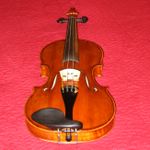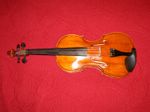Sunday, February 20, 2005
Ode to a Violin
 A couple of weeks ago, at the end of an English Country Dance, one of the dancers asked me about my violin: Did I buy it from a violin shop here in Seattle? Who made it? She wants to buy a violin, and doesn't know where to look. I'm not familiar with local violin shops, but I had some suggestions for her about how to look for an instrument. And while the man who made my violin is, I assume, still alive, I know very little about him.
A couple of weeks ago, at the end of an English Country Dance, one of the dancers asked me about my violin: Did I buy it from a violin shop here in Seattle? Who made it? She wants to buy a violin, and doesn't know where to look. I'm not familiar with local violin shops, but I had some suggestions for her about how to look for an instrument. And while the man who made my violin is, I assume, still alive, I know very little about him.I began looking for a new violin late in 1990. I was still playing the German student violin that had been given me by my older cousin, a lapsed junior high violinist, when I decided to play. After seven years of orchestra and violin lessons, I had abandoned the violin as soon as I graduated from high school. For 10 years, my violin languished in a closet at my parents' house. I picked up the violin again in 1988, because the traditional dance groups with which I danced needed musicians. My student instrument was fine for retraining myself to play, but after a couple years of playing again, I was ready for something else. The rather bland, quiet tone of that violin was well-suited to blending into an orchestral section. I wanted an instrument with its own unique voice.
I was already a customer of a good violin shop, where I'd had some work done on my violin and bow. The owner, Jim Scoggan, was a symphony bassist, a skilled luthier, and a genuinely nice guy. On what I now recognize as the first day of my search, I went to Jim's shop to pick up a bow that he'd rehaired for me. As we were chatting, I told Jim that I wanted an instrument with a richer, more distictive sound. While Jim's response was simply "do you want to try a few now?" the look on his face said "this will be fun."
One wall of the shop was fitted with deep shelves divided into violin-sized spaces. Jim would study the shelves, then pull out a violin, tell me something about it while he checked the tuning, and hand it to me to play. We'd talk about the characteristics of the violin's sound, what I liked or didn't like about it. Based on my reaction, Jim would keep that violin out or put it back, then pull out another one. I'd play the new one, play another one that was out, play my own, choose which I liked best. An hour and a half later, I had played 8 or 9 violins, and both Jim and I had a sense of the sound that I liked. I was not yet ready to take any home for further trial, but the search had begun. For almost a year, I stopped by Jim's shop every month or so to play recent acquisitions and a couple of favorites from earlier visits.
In September of 1991, Jim's face lit up when I walked into the shop. His partner had been on a buying trip in Italy, and Jim had just put strings on one of the new violins. He hadn't heard it played yet, and he wanted me to try it out. This really was a new violin, made that year. It didn't have the patina of age and use that I loved in the late 18th and 19th century violins that had until now been my favorites. However, when I drew a bow across its strings, this violin sang to me. It had a clear, sweet tone with just hint of darkness. I knew that, with time and playing, its voice would "open up" and become even lovelier. Finding the right violin is a little like falling in love. While I do not fall easily, I have once or twice fallen quickly. I took the violin home that Saturday for a five-day trial. On Tuesday, Jim called to ask when I'd be bringing it back; another violinist - an acquaintance of mine - was interested in seeing it. On Wednesday, I bought my violin.
 My violin was made in Cremona, Italy in 1990 by Nilton Fontoura, a student at the Istituto Professionale Internazionale per l'Artigianato Liutario e del Legno Antonio Stradivari. (That is, translated literally, the International Professional Institute of the Art of Luthiery and Wood; the English language version of their website calls it the School of Violinmaking.) The school's online listing of its graduates indicates that Fontoura is a Brazilian, born in 1963, who graduated from their 5-year program in 1995. If he went straight through school, he made my violin during his first semester of the program. Jim's partner bought several violins from students at the school, but he had no information about how to contact them, so this is all that I know of the man who made my violin.
My violin was made in Cremona, Italy in 1990 by Nilton Fontoura, a student at the Istituto Professionale Internazionale per l'Artigianato Liutario e del Legno Antonio Stradivari. (That is, translated literally, the International Professional Institute of the Art of Luthiery and Wood; the English language version of their website calls it the School of Violinmaking.) The school's online listing of its graduates indicates that Fontoura is a Brazilian, born in 1963, who graduated from their 5-year program in 1995. If he went straight through school, he made my violin during his first semester of the program. Jim's partner bought several violins from students at the school, but he had no information about how to contact them, so this is all that I know of the man who made my violin.While my violin is a lovely instrument and a joy to play, there are details that, to my mind, show it to be the work of a student. The f-holes (the curved openings in the top of the violin) are more angular than usual. This could have been an aesthetic choice, but that seems unlikely to me at the very traditional Cremona school. The varnish on the ribs shows brush marks, and there's even a small hair embedded in the varnish on one side. And while the coat of varnish is fairly thick (perhaps too thick), there are a couple of spots where it has chipped or crazed slightly. Most violins have a fancy printed label, affixed to the inside of the back, that indicates the maker and shop location. The year the violin was made, and sometimes the number of the violin, are handwritten on the label. Visible through the f-hole of my violin is a small slip of white paper bearing only the handwritten words Nilton Fontoura, Cremona, 1990. I imagine that, as a student, Fontoura could not afford to have labels printed for his first instruments. These details have become, like the eccentricities of a loved one, part of what I love and cherish about this instrument.
I've been playing this violin since 1991; I expect that it will be with me for the rest of my life. Its sound has opened up, becoming stronger and sweeter, the instrument more responsive and more nuanced as I play it. And my musicianship has grown with it, acquiring greater subtlety and power. It takes around 50 years for the voice of a violin to fully mature; I acquired this violin near my 31st birthday. If I am lucky, I may as a very old woman hear the fully developed voice of my violin. When I am gone, my violin will be passed on, with the beginnings of that patina of use that I so love in old instruments, to another violinist, one who I hope will cherish it as much as I do.


 Music and Cats
Music and Cats